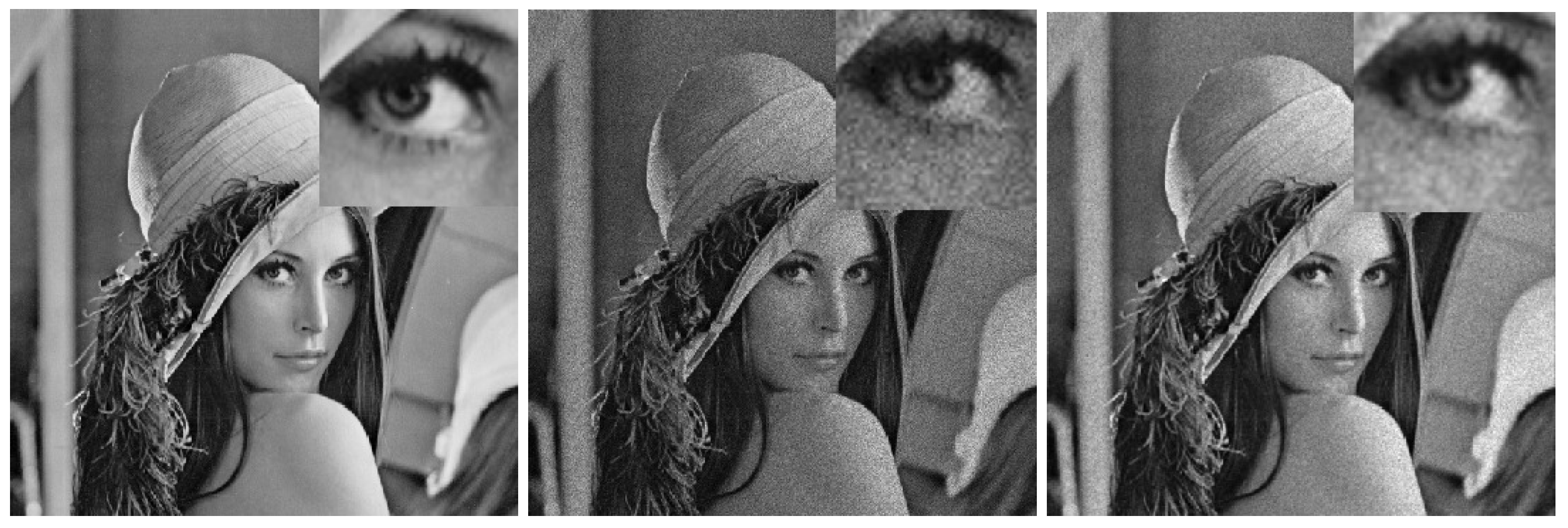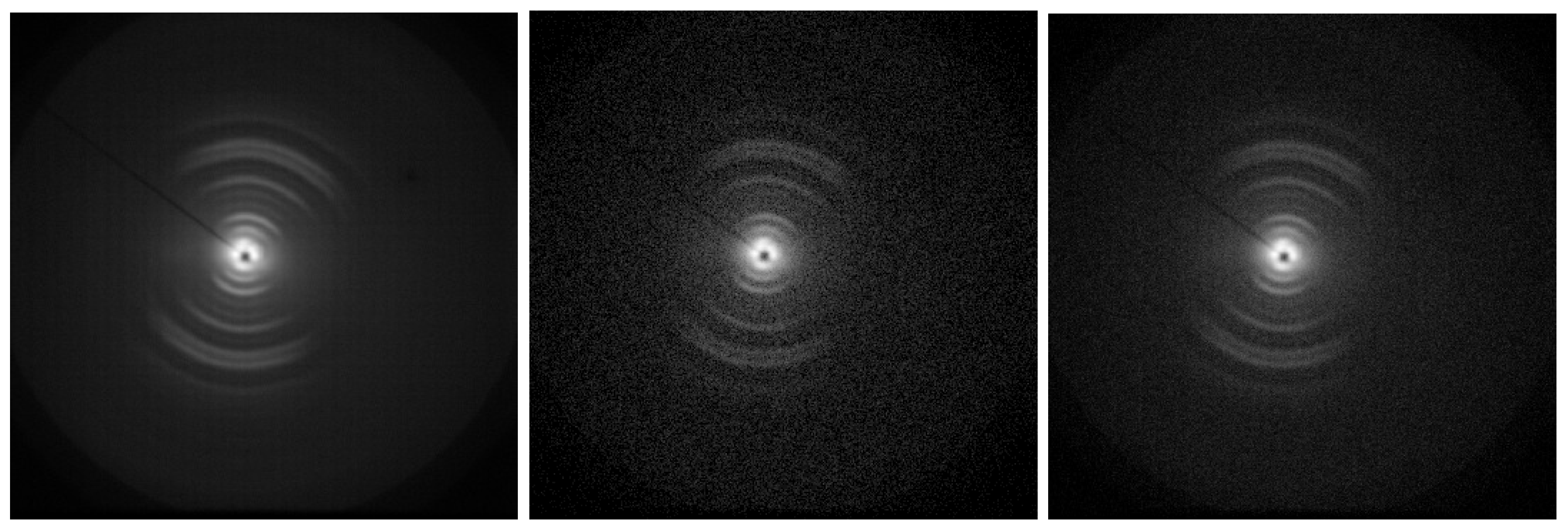Denoising X-Ray Diffraction Two-Dimensional Patterns with Lattice Boltzmann Method
Abstract
1. Introduction
2. A Fluidistic Approach
2.1. Lattice Boltzmann Method: Overview
- Discrete Lattice. The fluid is represented by particles moving on a fixed grid with discrete directions: the lattice dimensions (D) and the neighborhood (Q, the number of nearest neighbors, including the site itself) define the particular lattice Boltzmann method: e.g., D2Q9 means the nine nearest neighbors for each site on a two-dimensional lattice .
- Collision Step. Particles collide and exchange momentum according to probabilistic rules.
- Streaming Step. After collisions, particles move to neighboring lattice sites.
- Macroscopic Variables. From the particle distribution functions, macroscopic quantities like density and velocity are computed.
2.2. Lattice Boltzmann Method: Application
3. Results and Conclusions
- Diffraction peaks, which indicate the presence of crystalline regions while their position and intensity can help determine the fiber’s crystallinity and the arrangement of its molecular chains.
- The intensity distribution of the peaks in the pattern, which can show how the crystalline regions are distributed and oriented relative to the fiber axis.
- Azimuthal scans, which can be used to study the orientation of the crystallites around the fiber axis, revealing information about fiber alignment and texture.
Funding
Data Availability Statement
Acknowledgments
Conflicts of Interest
Appendix A. A Navier–Stokes Equation-Inspired Model
- Diffusion Equation. This equation models the process of substance spreading due to concentration gradients. It is typically written as , where c is the concentration of the substance, D is the diffusion coefficient, and is the Laplacian operator. It captures how substances diffuse through a medium over time.
- Navier–Stokes Equations. These equations describe the motion of fluid substances and account for viscosity and external forces. They can be expressed as follows:, where is the fluid velocity, p is the pressure, is the kinematic viscosity, is the density, and represents external forces.
References
- Pietsch, P.; Wood, V. X-Ray Tomography for Lithium Ion Battery Research: A Practical Guide. Annu. Rev. Mater. Res. 2017, 47, 451–479. [Google Scholar] [CrossRef]
- Sibillano, T.; De Caro, L.; Scattarella, F.; Scarcelli, G.; Siliqi, D.; Altamura, D.; Liebi, M.; Ladisa, M.; Bunk, O.; Giannini, C. Interfibrillar packing of bovine cornea by table-top and synchrotron scanning SAXS microscopy. J. Appl. Crystallogr. 2016, 49, 1231–1239. [Google Scholar] [CrossRef] [PubMed]
- Giannini, C.; Siliqi, D.; Bunk, O.; Beraudi, A.; Ladisa, M.; Altamura, D.; Stea, S.; Baruffaldi, F. Correlative Light and Scanning X-Ray Scattering Microscopy of Healthy and Pathologic Human Bone Sections. Sci. Rep. 2012, 2, 2045–2322. [Google Scholar] [CrossRef] [PubMed]
- Giannini, C.; Siliqi, D.; Ladisa, M.; Altamura, D.; Diaz, A.; Beraudi, A.; Sibillano, T.; De Caro, L.; Stea, S.; Baruffaldic, F.; et al. Scanning SAXS–WAXS microscopy on osteoarthritis-affected bone—An age-related study. J. Appl. Crystallogr. 2014, 47, 110–117. [Google Scholar] [CrossRef]
- Terzi, A.; Storelli, E.; Bettini, S.; Sibillano, T.; Altamura, D.; Salvatore, L.; Madaghiele, M.; Romano, A.; Siliqi, D.; Ladisa, M.; et al. Effects of processing on structural, mechanical and biological properties of collagen-based substrates for regenerative medicine. Sci. Rep. 2018, 8, 2045–2322. [Google Scholar] [CrossRef] [PubMed]
- Altamura, D.; Lassandro, R.; Vittoria, F.A.; De Caro, L.; Ladisa, D.S.M.; Giannini, C. X-ray microimaging laboratory (XMI-LAB). J. Appl. Crystallogr. 2012, 45, 869–873. [Google Scholar] [CrossRef]
- Ladisa, M.; Lamura, A. Diffusion-Driven X-Ray Two-Dimensional Patterns Denoising. Materials 2020, 13, 2773. [Google Scholar] [CrossRef] [PubMed]
- Hendriksen, A.A.; Bührer, M.; Leone, L.; Merlini, M.; Vigano, N.; Pelt, D.M.; Marone, F.; di Michiel, M.; Batenburg, K.J. Deep denoising for multi-dimensional synchrotron X-ray tomography without high-quality reference data. Sci. Rep. 2021, 11, 2045–2322. [Google Scholar] [CrossRef] [PubMed]
- Zhou, Z.; Li, C.; Bi, X.; Zhang, C.; Huang, Y.; Zhuang, J.; Hua, W.; Dong, Z.; Zhao, L.; Zhang, Y.; et al. A machine learning model for textured X-ray scattering and diffraction image denoising. npj Comput. Mater. 2023, 9, 2057–3960. [Google Scholar] [CrossRef]
- Oppliger, J.; Denner, M.M.; Küspert, J.; Frison, R.; Wang, Q.; Morawietz, A.; Ivashko, O.; Dippel, A.C.; Zimmermann, M.v.; Biało, I.; et al. Weak signal extraction enabled by deep neural network denoising of diffraction data. Nat. Mach. Intell. 2024, 6, 180–186. [Google Scholar] [CrossRef] [PubMed]
- Zhou, Z.; Li, C.; Fan, L.; Dong, Z.; Wang, W.; Liu, C.; Zhang, B.; Liu, X.; Zhang, K.; Wang, L.; et al. Denoising an X-ray image by exploring the power of its physical symmetry. J. Appl. Crystallogr. 2024, 57, 741–754. [Google Scholar] [CrossRef]
- Landau, L.D.; Lifshitz, E.M. Fluid Mechanics, 2nd ed.; Pergamon Press: Oxford, England, 1987. [Google Scholar]
- Chen, H.; Chen, S.; Matthaeus, W.H. Recovery of the Navier–Stokes equations using a lattice-gas Boltzmann method. Phys. Rev. A 1992, 45, R5339. [Google Scholar] [CrossRef] [PubMed]
- He, X.; Luo, L.S. Lattice Boltzmann Model for the Incompressible Navier–Stokes Equation. J. Stat. Phys. 1997, 88, 927–944. [Google Scholar] [CrossRef]
- He, X.; Luo, L.S. A priori derivation of the lattice Boltzmann equation. Phys. Rev. E 1997, 55, R6333. [Google Scholar] [CrossRef]
- Landau, L.D.; Lifshitz, E.M. Statistical Physics (Part 1), 3rd ed.; Pergamon Press: Oxford, England, 1980. [Google Scholar]
- Landau, L.D.; Lifshitz, E.M. Physical Kinetics, 1st ed.; Pergamon Press: Oxford, England, 1981. [Google Scholar]
- Landau, L.D.; Lifshitz, E.M. Mechanics, 3rd ed.; Butterworth-Heinenann: Oxford, England, 1976. [Google Scholar]
- Bhatnagar, P.; Gross, E.; Krook, M. A model for collision processes in gases. I. Small amplitude processes in charged and neutral one-component systems. Phys. Rev. 1954, 94, 511–525. [Google Scholar] [CrossRef]
- Kaushal, S.; Ansumali, S.; Boghosian, B.; Johnson, M. The lattice Fokker–Planck equation for models of wealth distribution. Phil. Trans. R. Soc. A 2020, 378, 20190401. [Google Scholar] [CrossRef] [PubMed]
- Canny, J. A Computational Approach to Edge Detection. IEEE Trans. Pattern Anal. Mach. Intell. 1986, PAMI-8, 679–698. [Google Scholar] [CrossRef]
- De Caro, L.; Giannini, C.; Lassandro, R.; Scattarella, F.; Sibillano, T.; Matricciani, E.; Fanti, G. X-Ray Dating of Ancient Linen Fabrics. Heritage 2019, 2, 2763–2783. [Google Scholar] [CrossRef]
- Wang, Z.; Bovik, A.C.; Sheikh, H.R.; Simoncelli, E.P. Image Quality Assessment: From Error Visibility to Structural Similarity. IEEE Trans. Image Process. 2004, 13, 600–612. [Google Scholar] [CrossRef] [PubMed]




| Image | Lenna | Lenna | Rat Tendon | sam4 |
|---|---|---|---|---|
| resolution | 512 × 512 | 512 × 512 | 1024 × 1024 | 1600 × 2500 |
| 1.15 | 1.15 | 0.85 | 0.85 | |
| 2.0 | 2.0 | 1.25 | 1.25 | |
| noise | 0.05 | 0.10 | - | - |
| PSNR (ini.) | 31.33 | 25.31 | 25.94 | 30.91 |
| PSNR (fin.) | 34.76 | 30.33 | 30.76 | 34.75 |
| SSIM (ini.) | 0.59 | 0.41 | 0.10 | 0.60 |
| SSIM (fin.) | 0.68 | 0.53 | 0.27 | 0.67 |
| Image | Lenna | Lenna | sam4 |
|---|---|---|---|
| resolution | 512 × 512 | 512 × 512 | 1600 × 2500 |
| noise | 0.05 | 0.10 | - |
| PSNR (ini.) | 31.33 | 25.31 | 30.91 |
| PSNR (fin., LBM) | 34.76 | 30.33 | 34.75 |
| PSNR (fin., Diff.) | 34.52 | 30.22 | 33.69 |
| SSIM (ini.) | 0.59 | 0.41 | 0.597 * |
| SSIM (fin., LBM) | 0.68 | 0.53 | 0.67 |
| SSIM (fin., Diff.) | 0.64 | 0.46 | 0.601 * |
Disclaimer/Publisher’s Note: The statements, opinions and data contained in all publications are solely those of the individual author(s) and contributor(s) and not of MDPI and/or the editor(s). MDPI and/or the editor(s) disclaim responsibility for any injury to people or property resulting from any ideas, methods, instructions or products referred to in the content. |
© 2025 by the author. Licensee MDPI, Basel, Switzerland. This article is an open access article distributed under the terms and conditions of the Creative Commons Attribution (CC BY) license (https://creativecommons.org/licenses/by/4.0/).
Share and Cite
Ladisa, M. Denoising X-Ray Diffraction Two-Dimensional Patterns with Lattice Boltzmann Method. Crystals 2025, 15, 51. https://doi.org/10.3390/cryst15010051
Ladisa M. Denoising X-Ray Diffraction Two-Dimensional Patterns with Lattice Boltzmann Method. Crystals. 2025; 15(1):51. https://doi.org/10.3390/cryst15010051
Chicago/Turabian StyleLadisa, Massimo. 2025. "Denoising X-Ray Diffraction Two-Dimensional Patterns with Lattice Boltzmann Method" Crystals 15, no. 1: 51. https://doi.org/10.3390/cryst15010051
APA StyleLadisa, M. (2025). Denoising X-Ray Diffraction Two-Dimensional Patterns with Lattice Boltzmann Method. Crystals, 15(1), 51. https://doi.org/10.3390/cryst15010051





